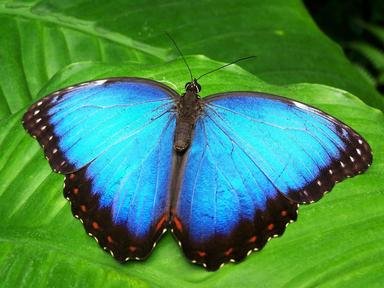Quiz Answer Key and Fun Facts
1. Examine a butterfly egg using a good magnifying glass, and a shallow depression can be seen at the top of the egg casing. Within this depression there are small openings that allow the male sperm to enter and fertilise the egg. The name given to these openings translates from the Latin as 'little doors' but what Latin word is used to describe these openings?
2. All caterpillars are alike in one respect, this being the number of divisions or segments that the body is divided into. Including the head, how many segments are present in a caterpillars body?
3. If a caterpillar was totally immersed in water for a period of time, would this result in certain death for the caterpillar?
4. The next stage in the life of a butterfly is its pupal stage. The Latin word 'pupa' (plural 'pupae') translates into what in English?
5. Some species of butterfly, notably the fritillaries and tortoiseshells, suspend themselves in the pupal stage, head downwards and attached by a hook arrangement at the base of the chrysalis. By what scientific name is this hook arrangement known?
6. What is the name given to the long feeding tube that butterflies possess and is usually carried curled up underneath the head?
7. What name is given to the leading edges of a butterfly's forewing and hindwing?
8. There are a number of species that attain the adult form twice during the year. What term is given to describe the variations that often occur between these first and subsequent broods of the same species of butterfly?
9. Which family of butterflies, that contains most of our blue coloured species, is remarkable in that a large number of family members are attended during the larval and pupal stages by ants?
10. I am a striking butterfly of the family Nymphalidae. I have black wings with vivid red markings toned down by the addition of splashes and dots of white on my forewings. My hindwings are edged with blue and red, accentuated with dots of black. Often seen feeding on rotten fruit and on nectar from the flowers of the Buddleia bush, my Latin name is Vanessa atalanta, but by what name am I commonly known?
11. Another member of the family Nymphalidae, this butterfly takes its common name from the 'surprising' markings on its forewings and hindwings. Carrying one of these distinctive markings on each wing, its Latin name is Inachis io. What is the more usual name given to this common insect?
12. This butterfly, a member of the family Pieridae which contains many of the common species of white butterflies, is uncommon in Britain but is relatively common in mainland Europe. Its Latin name is Pontia daplidice but by what name is it usually referred to in these islands?
13. Another member of the family Nymphalidae, this is a beautiful but relatively rare immigrant species to these islands. The wings are chocolate brown enhanced with a row of blue spots just before the ochreous edging to its wings. Known in the United States as 'The mourning cloak', by what name is this butterfly known in Britain?
14. Often to be found flying amongst the upper leaves and branches of the tallest trees in the woods of the midland and southern counties of England, this butterfly only descends to indulge in its passion for rotten fruit, carrion and dung. The male of this species possesses a beautiful colouration to its wings that is only seen when viewed from the correct angle. Its Latin name is Apatura iris. By what name is this insect more commonly known?
15. Another member of the family Pieridae, this butterfly has pointed tips to its forewings and possesses a bright sulphurous yellow colouration. If it is possible for butterflies to exist in Hell, this is the species that would be most likely found there!
Source: Author
SisterSeagull
This quiz was reviewed by FunTrivia editor
crisw before going online.
Any errors found in FunTrivia content are routinely corrected through our feedback system.
